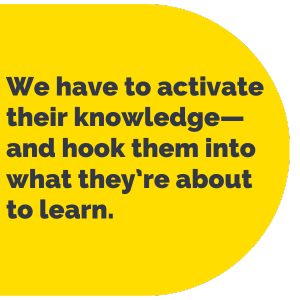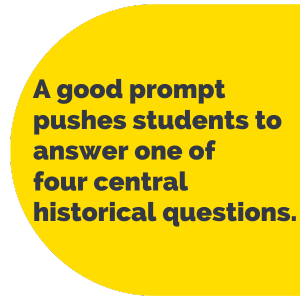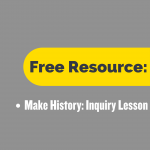Picture this: You’re about to teach one of your favorite history lessons. It’s a subject so nuanced and relevant that you want your students to come out of the lesson with the same passion and understanding that you have. It sounds simple. Yet the reality can be far different. Too often, when the day finally arrives, the lesson falls flat. It’s like pulling teeth to get students talking, thinking, or writing. Why does it go wrong?

It starts with how class begins. To activate students’ passion for history, we have to activate their knowledge—and hook them into what they’re about to learn. Our new book, Make History: A Practical Guide for Middle and High School History Instruction, shares best practices from hundreds of educators on how to foster engaging, rigorous history classrooms. Two of those key components are part of the lesson launch: knowledge activation and the hook. Let’s see how these play out in US History teacher Jillian Gaeta’s lesson on African American activists Booker T. Washington and W.E.B. DuBois.
Set the Stage for Learning
Here is the simple Do Now (a five-minute written prompt) that Jillian uses to start the lesson:
- What challenges were African Americans facing at the end of Reconstruction?
After the students complete the Do Now, here is what Jillian says:
“As you noted, African Americans are facing all these issues after Reconstruction. As an activist during this time, you’re faced with some tough decisions. You’re not sure what is the most important thing to prioritize, or how you need to tackle all these issues. What would be the most important issue for you to prioritize?”
In these two simple moves, Jillian makes the learning come alive by giving access to students:
- Activates Knowledge: In this section of the unit, students are building knowledge of the Jim Crow Era, a period of repression that reversed many of Reconstruction’s ground-breaking advancements for African Americans. Using the Do Now to generate a list of challenges facing African Americans during this time activates students’ prior knowledge, priming them to use it later in the lesson when they analyze new sources.
- Hooks Students: Jillian wants students to immerse themselves in this historical dilemma. So, she asks them to consider these challenges as if they were activists during this time. Not only does this foster historical empathy (students sometimes struggle to understand why people from the past made certain choices), but it also engages students with a rigorous task —choosing and justifying the most important challenge to prioritize out of many. Although Jillian poses the initial question, the hook and turn-and-talk prioritizes the ideas and voices of her students. If authentic intellectual engagement is the goal for the lesson as a whole, the hook is a place early in the lesson to establish that culture.
Yet this opening does not only serve as a means of engaging students—it sets up the driving question of the day.
Make Your Question of the Day Provocative
Jillian introduces the following prompt.

“Booker T. Washington and W.E.B. Du Bois offered different strategies for dealing with the problems of poverty and and systemic racism faced by Black Americans at the end of the nineteenth and beginning of the twentieth centuries. Using the documents and your knowledge of the period 1877-1915, assess the appropriateness of each of these strategies in the historical context in which each was developed.”
In one well-designed prompt, Jillian has taken students’ initial interest and rooted it deeply into the historical context to evaluate key actors of the time period.
Designing a compelling and substantive prompt that is grounded in historical thinking is not always easy, but with a few key thinking questions you can craft your own. Bassett and Shiffman of 4QM (The Four Question Method) argue that a good prompt pushes students to answer one of four central historical questions:
- Question 1: What happened?
- Question 2: What were thinking?
- Question 3: Why then and there?
- Question 4: What do we think?
We go into more detail about strong prompts and historical questions in Make History: A Practical Guide for Middle and High School Instruction, but our friends at 4QM have led the way on this. See their work here.
Release Students to the Challenge
With these first 10 minutes of class, Jillian has not only prepared her students for the challenge that lies ahead but she has gotten them excited to tackle it. Her class is primed to take off:
Launch the Lesson |
|
Activate Knowledge Retrieval
|
Start class with a 3-5-minute independent Do Now that activates the prior knowledge student will need for the day’s inquiry. |
| Hook Students | Provide context for the day’s inquiry. Use a thought-provoking hook to engage interest. Tie the day’s topic to what was previously learned and the over-arching story of the week, unit and/or year. |
| Introduce the Question of the Day | Share a provocative inquiry question that will drive the learning. |
The lesson launch is the first part of the rigorous inquiry lesson. To see the full arc, download the Inquiry One-pager.
For more information on how to start class strong, read Part 2 in Make History: A Practical Guide to Middle and High School Instruction. The moves we share are bite-size, actionable, and most importantly, replicable.





